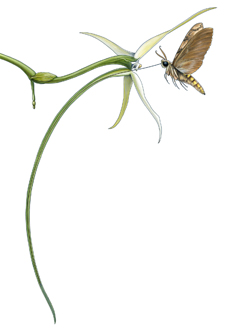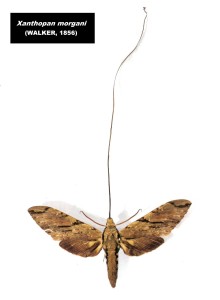In a recent discussion thread, one of my readers asked about cooperative evolution. After a brief discussion, what he was interested in was coevolution. So here you go Void.
Coevolution is a well known concept in the biological community. But, as I often do, I fired up my citation manager to see what was current on a topic. Typing “coevolution” into PubMed results in over 100 hits (for 2014 alone) dealing with coevolution.[1] That’s more than one paper per day (at a minimum) for something that creationists often say is impossible. So what do we mean when we say coevolution.
According to Kevin Yip and Prianka Patel (and others) at Yale University,
Coevolution (covariation/correlated mutation) is the change of a biological object triggered by the change of a related object.
What we mean is that an evolutionary change in one population is somehow caused by an evolutionary change in another population. There are thousands of examples of this. Indeed, if you think about evolution as survival of the fittest (or of the frequent) then almost all evolution is coevolution. Evolution, the change in allele frequency in a population is the result of some cause, whether it be another biological population or an environmental effect.
Gould and Mayr’s punctuated equilibria (original 1977 PDF) theory suggests that populations of organisms are generally stable unless acted upon by an outside force. Even Darwin was well aware that humans often and relatively easily cause changes in populations based on needs or desires. The several hundred breeds of dog that exist today all descended, with modification, from wolves starting about 30,000 years ago. Indeed, modern dogs, while able to interbreed with wolves are so different as to be considered a different species. Humans have directly influenced the evolution of hundreds of plant and animal species for food and entertainment. Just to list a few: roses, cattle, chickens, pigeons, varieties of cabbage including broccoli and kale, maize/corn, wheat, and dozens of insects (indirectly). But this isn’t really coevolution, this is us changing something.
Nothing evolves without influence from something else. In a very real way, we are connected to everything on Earth. We exist because of the history of life, the influences of millions of other species, and the environments that our ancestors lived in. In turn, we have directly and indirectly influenced millions of populations to change as well. Sorry for the digression.
In his book “The Greatest Show on Earth“, Richard Dawkins describes several examples of coevolution. It seems like he took all the good ones too.
Let’s take an easy example. Bacteria. Humans don’t like being sick. When bacteria infect modern humans, we gear up and go to war. We have developed a variety of chemicals that destroy bacteria. Chemical warfare is only illegal against other humans. Against bacteria, it’s plenty acceptable. So, we have created an environmental change in our bodies. When we get bacteria we don’t like. We attack. Bacteria mutate easily. The so-called SOS response. Bacteria that survive the barrage of chemicals designed to kill them make up much more of the gene pool than those that didn’t do so well against the antibiotics. Which, of course, is why your doctor always tells you to take all of your antibiotics. Even creationists who don’t accept evolution still take all their antibiotics.
So the bacterial population is evolving to be resistant to antibiotics. In the same way we can look at something like flowers and insect pollinators. Dawkins described it well, I’m going to shorten it considerably. It is spring here in Texas and it seems like every plant is purposefully pumping pollen into my nose in order to kill me. That’s not their purpose. Those plants (oak and cedar mainly) have a really stupid way of sexually reproducing. The males make tons of pollen, then eject it into the wind and hope for the best. The best being that one pollen grain lands on the female part of another tree of the same species. It takes a lot of energy to make all that pollen. And that’s energy that might be more usefully spent somewhere else.
Some flowers have a different system. They get some help. Flowers and various insects have coevolved. One the one hand, the flower has evolved to be attractive to insects, usually a specific species or group (even the disgusting carrion flowers). The attractiveness to insects takes many forms. Some flowers give the insects a high energy treat (nectar). Some have become shaped like a female insect. Some give off a smell that attracts insects. Some have developed a complicated arrangement of colors that alert insects to the presence of nectar. And some do some or all of these. The goal is to attract insects that will then get pollen stuck to them. As the insects visit several flowers, the pollen gets rubbed up against the female parts of the flower.
Insects have evolved in tandem, with certain groups or species being attracted to one or more types of flowers. Some insects and plants have evolved rather elaborate structures for this process. Like the Hawk moths and orchids of Madagascar.


Natural History Museum of London
The nectar for the moth is contained in that long bit hanging down under the flower. So the moth has evolved a tongue that, in some cases, is well over 9 inches (22.9 cm) long. An extreme, but not uncommon example of coevolution.
This relationship, between plants and their insect pollinators, is mutualistic. Both species get a benefit. But that’s not always the case. Most of the real world is actively trying to eat and/or avoid being eaten. The often called “arms race” between organisms fits here. Big cats that are bigger and stronger are capable of taking larger prey that is closer to the herd (herding being a defensive mechanism). Still, it’s easier to kill smaller animals farther from the herd. So the big cats are causing the prey species to evolve into larger, better herding animals. The weaker, smaller predator species has trouble getting enough animals to survive, so the predator population tends to be larger and stronger too.
I’ve used an example of this long before, but I’m not entirely sure of the accuracy of it now. I’ve attempted to update this description with information in parentheses. Cheetahs are fast (with high acceleration and awesome maneuverability) . Still, it’s a lot easier to catch a slow (less maneuverable) gazelle. So the gazelles that survive tend to be faster (and more maneuverable). The cheetahs that are fast (and maneuverable) don’t have any problems, but the slower cheetahs (for whatever reason) tend to have more trouble catching appropriate prey. So the cheetahs are evolving to be faster (and more maneuverable).
Over time, you get both predator and prey populations that are insanely fast (and maneuverable).
So coevolution is a big workhorse process in the real world and has led to some… interesting species in our wold.
_____________________________
[1] This research has also led to me adding about two dozen papers to my personal collection.
